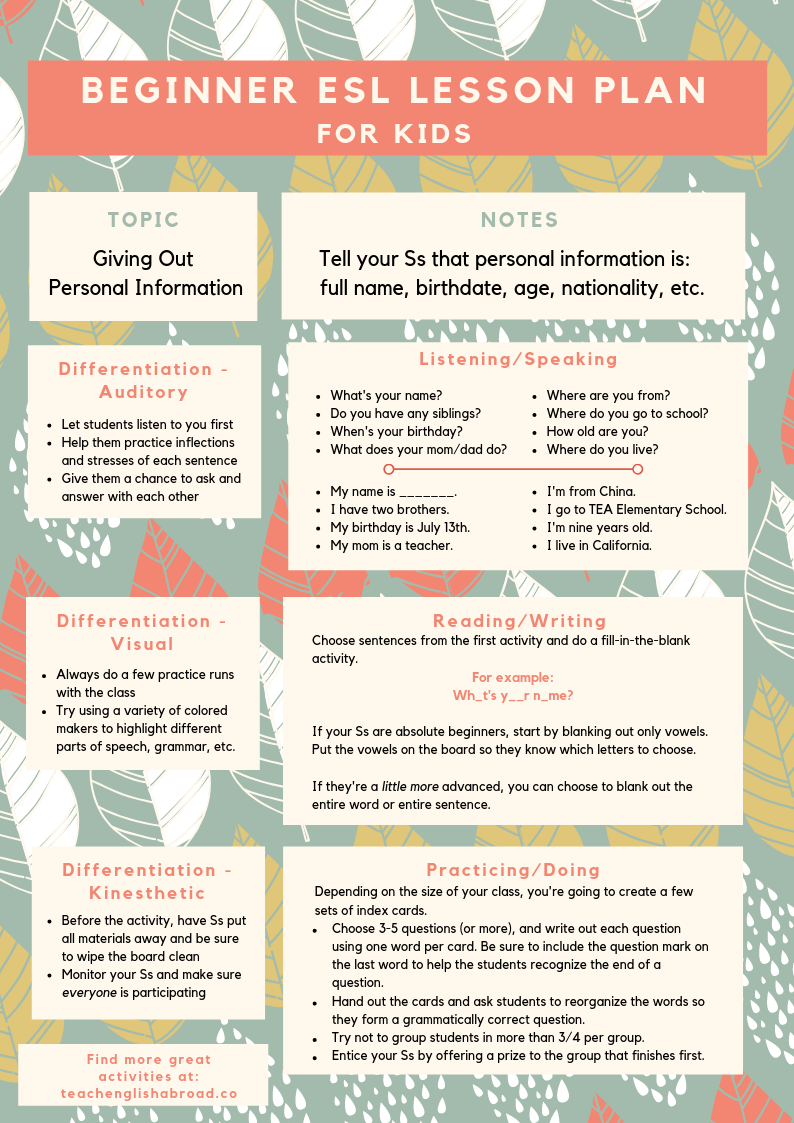5 Beginner ESL Lesson Plans You Need To Try
Help your students retain what they learn and have fun doing it.
One question I get asked often is, “How do you teach people who don’t speak your language?”
I’ll admit that teaching absolute beginners in any language is difficult. But when you teach beginners in a language that isn’t their own, you have extra hurdles to jump over.
As an ESL instructor, the language you’re using to help guide your students’ understanding has to be as simple as possible - which isn’t always easy to do.
Even more, the pace at which you teach, the mediums you use to teach, how you choose to assess your students and a bunch more also contribute to the success or failure of your English language learners.
In my experience, the things that make beginner ESL lessons not only sticky - but also engaging - are simplicity, repetition, and differentiation of process or how they learn what you’re teaching them either by watching, by listening, by doing, or a combination of all three (the best).
Let’s explore what this looks like in a lesson plan.
Functional
One of the best ways to get students talking is by presenting them with scenarios they’re likely to encounter on a daily basis.
And no, I’m not talking about those super lame, robotic English sentences like “Where is Brian?” “Brian is in the kitchen.” (comment below if you get that reference, HA!)
I’m talking about more fundamental English, like saying hi, bye, or giving out personal details. These are things students hear daily and should get comfortable responding to.
The lesson below is simple, provides several chances to repeat what the students have learned, and differentiates how the students process the content they’re learning. Win-win.
A few notes on the lesson plan above.
The lesson plan can be easily modified for ESL adult beginners by changing some of the questions to ones adults would likely encounter such as “what’s your phone number/email address, where do you work, what did you study, etc”
Additionally, you might be tempted to teach students formal English in the beginning, meaning teaching without contractions (“What is” rather that “What’s”).
But if your goal is to get students speaking, they don’t need to understand what a contraction is just yet. They need to know what a sentence means, how to say it, and how to respond to it.
Remember, native English speakers don’t talk like robots! If speaking is the goal, then it’s better to teach students English they’re likely to hear rather than English they’re likely to read.
Authentic
Speaking of being genuine, any time I can insert anything real into a lesson I jump at the chance - even with beginners.
I need to make the point that when you’re working from a book, lessons can sometimes feel stale because they’re packaged to fit the book rather than real life. That’s why incorporating authentic ESL lesson plans into your regime is crucial.
There are thousands of possibilities for ESL beginners to experience authentic materials, such as menus, brochures, tables of content, or anything else that contains short, concise information.
This is a fantastic example of an ESL lesson plan on travel where students will be able to
Produce a travel information packet (flyer, brochure, powerpoint, wiki, etc.) with useful information about a region, country, city, or town.
Focus on a particular grammar point based on their language proficiency.
Present their travel information to the class in a 7–10 minute group presentation.
Obviously, for ESL beginners, you’ll need to modify this lesson plan but the outline is there.
The point of this beginner ESL lesson is to get students familiar with reading and engaging in authentic literature.
Phonetic
Yes, phonics have to be taught and they’re one of the most difficult things for native English speakers to teach.
Many of us have no clue which phonetic symbols belong to which sounds, but neither you nor your students can skip this fundamental ESL lesson.
Phonetic sounds help students understand words, which helps them build vocabulary, which helps them learn to read and speak.
Try this super simple lesson on rhyming phonetic sounds that have wildly different spellings. This will bewilder (and possibly frustrate) your students, but it will also strengthen their memories and help build a robust vocabulary of English sounds.
The format of this lesson plan follows the Gradual Release of Responsibility method.
academic
At some point you’re gonna have to buckle down and teach some serious English! You know, grammar rules and whatnot.
Luckily, there are tons and tons of free materials on the interwebs designed to prevent your students’ eyes from glazing over while you’re teaching.
Learning grammar can be fun! *cough*
This particular resource is a treasure trove of very simple, yet impactful ESL lesson plans for adult beginners that you can tailor to fit your teaching style and your students.
leisure
Sometimes you just need to toss in a random lesson for variety. I like to call them leisure lessons where you learn about famous people, or famous places, or something else that’s the opposite of strict academic rigor.
These kinds of beginner ESL lessons are more relatable to students and can sometimes help in removing barriers of speech by giving them a topic they’re already familiar with.
When possible, try to find something that is closely connected to their culture or background.
Start here, here, or here for some of the best leisure ESL lesson plans for beginners.
Still looking for someone to just write your lesson for you? Try some of my beginner ESL lessons that are packed with teaching strategies, activities and assessments for your beginner students.



